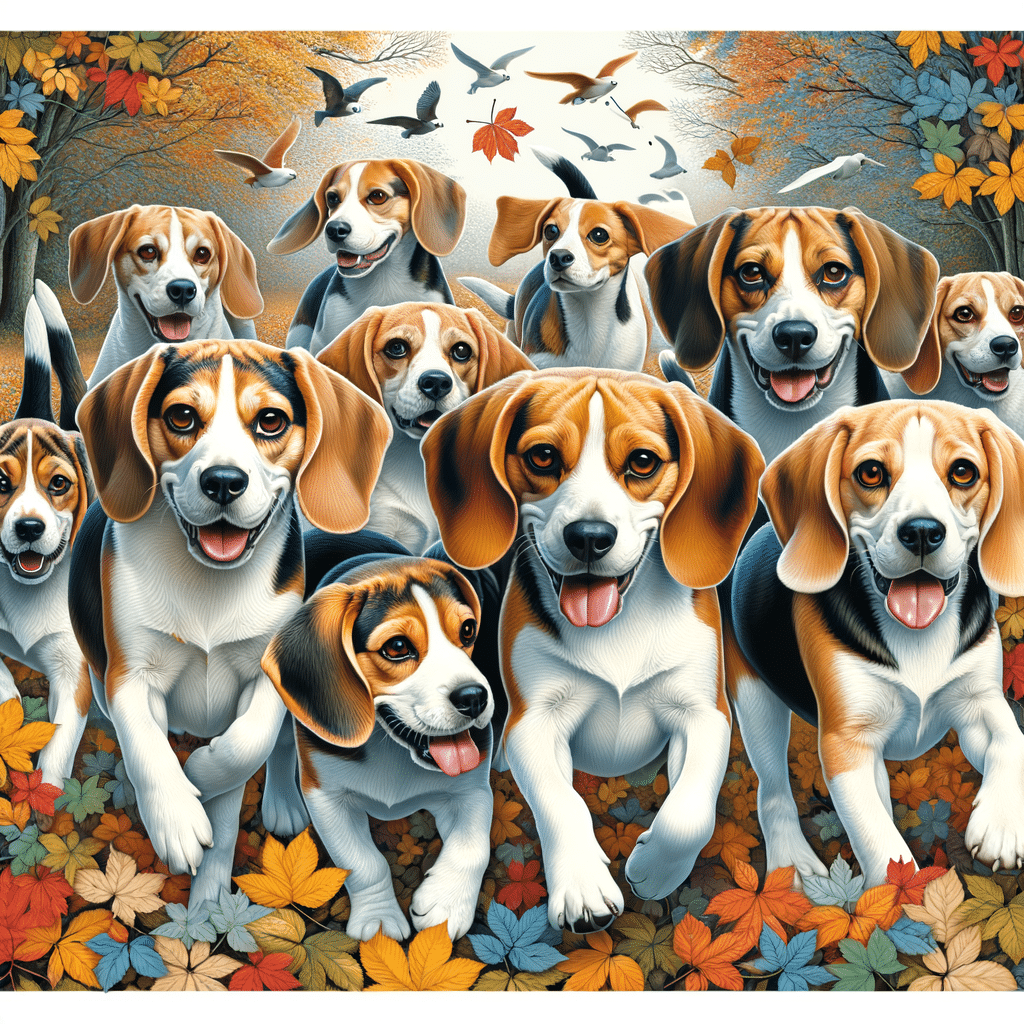When comparing dog breeds, such as the beagle and the rottweiler, prospective pet owners should consider various factors like physical characteristics and overall health. When considering a beagle vs. a rottweiler, a side-by-side overview is often the best way to select the perfect dog for you.
In This Article
Beagles are smaller hounds known for their keen sense of smell and tracking instincts. They originated from England for hunting purposes. They are generally joyful, determined, and adventurous.
On the other hand, rottweilers are larger, powerful working dogs that came from Germany. They were traditionally bred to herd livestock and serve as guard dogs. They have a confident and composed demeanor, but because of their strong-willed nature, they are not usually good for inexperienced dog owners.
Understanding each dog’s behavior and temperament is crucial, as they can impact its compatibility with your family environment. Because of their friendly and playful nature, beagles are excellent with children and a good choice for new owners. While rottweilers are also good with children, they require firm, consistent training and socialization because of their protective instincts.
Care and maintenance of these breeds differ, with beagles needing regular exercise to satisfy their exploratory urge and rottweilers requiring physical and mental stimulation to keep them engaged.
Highlights
- Beagles are small, friendly dogs ideal for first-time owners, while rottweilers are larger and better suited for experienced owners.
- Both breeds are good with children but have distinct care requirements and temperaments.
- Proper training and socialization are important for rottweilers, whereas beagles need ample exercise to manage their energy levels.
Breed Profiles and Origins
Discover the unique histories and origins of two distinct canine breeds: the beagle and the rottweiler. These dog breeds have diverse characteristics and fulfill different roles.
Beagle: An Overview
Originating from England, the beagle is a small- to medium-sized dog known for its hunting capabilities and keen sense of smell. Classified within the breed hound group by the American Kennel Club (AKC), beagles rank high in popularity due to their friendly and affectionate temperament. They have intelligence and curiosity, which aids them in their traditional role as scent breed hounds. Historically, beagles have been employed to hunt small game due to their instinct for tracking. Typically, the breed sports a tricolor coat, although other varieties exist.
Rottweiler: An Overview
The rottweiler is a large breed with an origin traced back to Germany, belonging to the working group recognized by the American Kennel Club. Known for their protective and loyal nature, rottweilers have been used for guarding and other work-oriented tasks. They have a robust frame indicative of their utility as service and working dogs.
Rottweilers express impressive intelligence and a temperament tailored for loyalty and guarding roles. Despite their intimidating presence, they display a clear, confident temperament when well-trained. The breed’s history suggests they may have descended from Roman drover dogs, adapting to various roles alongside humans for centuries.
Physical Characteristics and Health
When comparing beagles with rottweilers, it is important to understand that they differ significantly in size, weight, and health predispositions due to their breed specifics.
Comparing Size and Weight
Beagles
- Size: Small to medium
- Height (Male/Female): 14-16 inches
- Weight (Male/Female): 20-30 pounds
Rottweilers
- Size: Large
- Height (Male/Female): 24-27 inches (Male), 22-25 inches (Female)
- Weight (Male/Female): 95-135 pounds (Male), 80-100 pounds (Female)
Common Health Concerns
Beagles may suffer from the following health issues:
- Hip dysplasia: A malformation of the hip joint, resulting in pain or arthritis.
- Epilepsy: A neurological disorder that can cause seizures.
- Patellar luxation: Dislocation of the kneecap.
- Allergies: Can lead to skin and ear infections.
- Other issues: Additionally, they might experience Intervertebral Disk Disease and eye conditions such as Cherry Eye, Distichiasis, and Glaucoma.
- Average lifespan: 10 to 15 years
Rottweilers are prone to:
- Hip and elbow dysplasia: Joint malformations that can result in arthritis or lameness.
- Aortic stenosis/Subvalvular aortic stenosis: A heart condition that can cause fainting or sudden death.
- Osteosarcoma: A type of bone cancer.
- Bloat/Gastric Dilatation-Volvulus (GDV): A life-threatening condition involving the stomach.
- Average lifespan: 8 to 10 years
Both breeds are purebred dogs, which can mean a propensity for inherited health problems. Still, with proper care, regular veterinary checks, and responsible breeding practices, many health issues can be managed or prevented, helping you ensure you have healthy dogs. You also may want to purchase dog insurance for additional peace of mind.
Behavior and Temperament
In assessing the behavior and temperament of the beagle and rottweiler, one must consider each breed’s traits. Their personalities set them apart, greatly affecting their interaction with family and other pets.
Personality Traits
Beagle
- Temperament: Joyful, adventurous, and friendly.
- Playfulness: High; they are energetic and inquisitive.
- Independence: Moderate; Beagles are sociable but can also be stubborn.
Rottweiler
- Temperament: Confident, loyal, and protective.
- Playfulness: Moderate; playful with family but more reserved than Beagles.
- Independence: Strong; Rottweilers are self-assured and can be independent.
Interaction with Family and Pets
Beagle
- Family: Affectionate and kind, Beagles are excellent with children.
- Pets: Generally pet-friendly; they enjoy company and are sociable with other dogs.
Rottweiler
- Family: Loyal and protective, making them alert to strangers and excellent guardians.
- Pets: Can be pet-friendly with proper socialization; their strong nature requires careful introductions to other pets.
Behavioral Training and Adaptability
Beagle
- Training: Intelligent but may be stubborn; consistent training is required.
- Adaptability: They are adaptable to various environments, but they are not ideally suited for apartment living due to their energy and vocal tendencies.
Rottweiler
- Training: Highly intelligent and trainable; responds well to firm, consistent training.
- Adaptability: They are adaptable, especially if given sufficient exercise; their size and exercise needs make them less suited for small living spaces.
Care and Maintenance
When choosing between a beagle and a rottweiler, you should consider the care and maintenance each breed entails, focusing on their unique needs in exercise, grooming, and suitability to varying home environments.
Exercise and Energy Levels
Beagles are naturally active and playful, requiring daily exercise to satisfy their energy levels. These dogs thrive on walking, playing fetch, or participating in canine sports. In contrast, rottweilers also possess a high energy level, but they often display it through powerful bursts. Daily exercise that includes walks, play times, and mental stimulation is crucial to balance them.
Beagle
- Energy level: High; needs at least 1 hour of exercise daily.
- Playfulness: Enjoys interactive games and scent-tracking activities.
Rottweiler:
- Energy level: High; requires 1-2 hours of exercise daily.
- Playfulness: Prefers structured play, including obedience games and strength training.
Grooming and Shedding
Grooming demands for beagles are relatively low. They have short coats that shed, but they typically require only weekly brushing. Rottweilers have a medium-length double coat that sheds more heavily, especially during the shedding seasons. They necessitate more frequent brushing, ideally twice a week, to manage loose fur and keep their coat healthy.
Beagle
- Shedding: Moderate; weekly brushing recommended.
- Maintenance: Low; occasional baths and regular ear checks due to their floppy ears.
Rottweiler
- Shedding: Heavier during seasonal changes; more frequent brushing is needed.
- Maintenance: Moderate; includes routine checks for signs of joint or bone issues.
Suitability for Home Environments
Beagles adapt well to apartment living, provided they receive sufficient exercise, but they may be prone to barking, which can be a consideration for noise-sensitive living spaces. They lack guard instincts, making them less suitable as protection dogs.
Rottweilers, known for their protection and watchdog capabilities, often do better in homes with ample indoor and outdoor space due to their size and territorial nature. Both breeds can adjust to living environments but need owners who understand and meet their needs for space and stimulation.
Frequently Asked Questions
When comparing beagles and rottweilers, prospective pet owners often have specific questions regarding their visual differences, as well as differences in temperament, size, and suitability for family life. This section addresses these common inquiries, helping you decide which breed to add as a new family member.
What are the temperament differences between beagles and rottweilers?
Beagles are known for their friendly and curious nature, often showing a playful and affectionate demeanor. They are good with children and make excellent family pets. Rottweilers, by contrast, exude calm confidence when properly trained and socialized. They tend to be active and strong, and can show a protective streak, which makes them less relaxed around strangers.
How does the size of a beagle compare to that of a rottweiler?
Beagles are a small- to medium-sized breed, typically standing 13-15 inches at the shoulder and weighing 20-30 pounds. Rottweilers are significantly larger, often standing 22-27 inches tall at the shoulder and weighing 80 to 135 pounds.
Which dog breeds are considered to be more powerful than a rottweiler?
Dog breeds considered more powerful than Rottweilers may include the mastiff and Saint Bernard because of their size and strength. However, “powerful” can be subjective and depends on the context, such as physical strength, bite force, or protective instincts.
What are the considerations for keeping a beagle as a household pet?
Beagles require plenty of exercise for their high energy levels. They may engage in vocal behaviors like barking or howling if not adequately stimulated. They can be challenging to train due to their independent nature. Beagles also have a strong sense of smell and may wander if they catch an interesting scent.
What traits contribute to beagles’ reputation as loyal dogs?
Beagles are known for their strong bond with their families. Their loyalty often occurs because of their desire to be part of family activities, gentle behavior with children, and social nature.
How suitable are rottweilers for a family environment?
When well-trained and socialized from a young age, rottweilers can be loyal and protective family pets. They do best with families that can provide consistent training and social interaction. Due to their size and strength, supervision around small children is advised.






